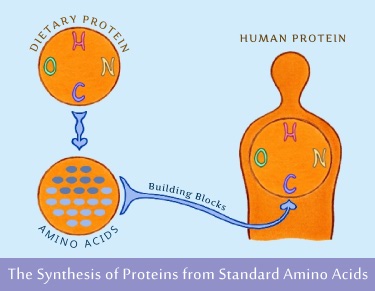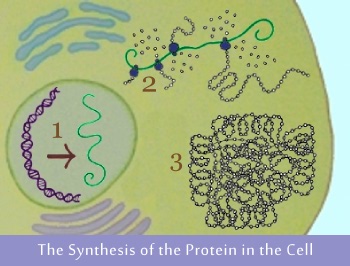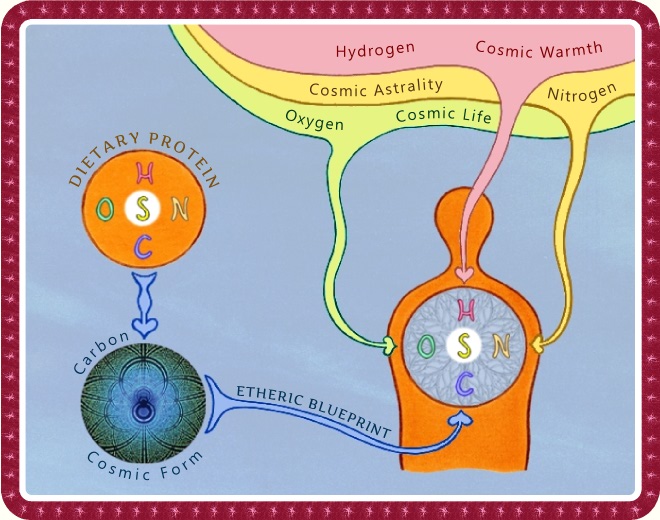In the flood of nutritional literature which originates from a materialistic
understanding of the world there is, among many other things, a stress on the
great importance of eating proteins which the human being needs for the renewal
of own body, to a great extent made from proteins. However, in this one fact
acknowledged by modern science the evidence that the human organism is capable
of synthesising its own proteins is often forgotten. The only question is, from
where does our body obtain these amino acids, the basic building blocks for the
synthesis of new proteins? For that reason we will first look at the scientific
explanation on how the human organism is making new proteins and then at the
spiritual scientific explanation of processes that participate in the creation
of human proteins.
Scientific Picture: Synthesis of Proteins from Amino Acids
After we have eaten the food is gradually, with the help of processes in
the digestive tract, broken down into its basic food components. In this
process the proteins in the food are broken down into
amino acids.
These are then absorbed into the blood circulation and are used in the cells
to create new proteins. Amongst the many amino acids existing in nature, the
human body needs only twenty plus for creation of its own proteins. For that
reason these selected amino acids are called 'standard amino acids'. They
are regarded as basic building blocks for synthesis of new proteins which
are indispensible for growth and for continuous renewal of our physical
organism. In this manner we arrive at a simplified picture of the
synthesis of proteins in the human organism.

These standard amino acids are further separated into two groups, in essential and nonessential amino acids.
[1] "Essential amino acids are 'essential' not because they are more
important to life than the others, but because the body does not synthesize
them. They must be present in the diet or they will not be present in the
body."
[2] What is usually overlooked when focusing on
essential amino acids is that the human organism can
synthesise all nonessential amino acids either from essential amino
acids or other intermediary products of human metabolism.
However, "the distinction between essential and non-essential amino acids
is somewhat unclear, as some amino acids can be produced from others" [3] and
because of the existence of 'conditionally essential amino acids' which
specific groups of people can synthesise and others can't. There are a few
more reasons for lack of clarity about what is essentially needed and what
is
not [4],
but in all this it is interesting that science does confirm that
the human
organism is capable of synthesising also amino acids, and not just proteins.

Now we will look inside our body by the agency of fascinating scientific
discoveries. With their help we can recognize in the synthesis of proteins
on the cellular level the following processes: [5]
| 1. Copying the genetic information |
| Each cell of the human body (except red blood
cells) contains within its
nucleus a
complete set of genetic information, called
genome,
in the form of the
DNA
double helix (violet). In the first stage of protein formation a
specific part of this genetic information is copied and forms a strand
called messenger RNA
(green). |
| 2. Forming the amino acid chain |
| This strand then leaves the cell nucleus and to it
the ribosomes
(dark blue) get attached. The ribosomes read the genetic information in
the strand and attach appropriate amino acids into a chain according to
the instructions contained in the genetic record. The outcome is a chain
of amino acids in specific sequence that determines the nature of the
protein. Its size can vary from a few hundreds to almost 27,000 amino
acids. |
| 3. Folding into three-dimensional structure |
| The last part of protein formation is the folding
of the long chain of amino acids into a complex three-dimensional
structure. The specific amino acid sequence and the final
three-dimensional structure determine the type of protein and its
specific function in the human organism. This structure also differs
between healthy and unhealthy protein (i.e., abnormally folded protein)
which cannot perform its function as needed. |
So far scientists have achieved great success in deciphering the language of
the genetic code and how it translates into instructions for the creation of
amino acid chain. This was the key for understanding the first two phases of the
process of protein synthesis. But they are rather baffled by the riddle of
protein-folding. For there are hundreds of millions of ways in which the amino
acid chain can fold and the longer the chain, the more possibilities exist. For
the simulation of all possibilities, phenomenal levels of computer processing
power are required. [6]
Even if in the future, with the development of supercomputers, scientists
succeed to perform the simulations of the folding of proteins, their number in
nature is so big that it will be extremely hard to finish with a book similar to
the one for the human
genome. And also, in the case that we were successful to
obtain more extended knowledge of their three-dimensional structures, this would
not mean that we knew what is guiding this process of folding. Thus we can say
that on a daily basis in each human body there are evolving, without our
knowledge, processes which demand the most powerful supercomputers in the world
just to make a virtual copy of them. Thus we see that, in the case of protein
creation, we encounter such startling complexity that it overcomes our
capacities of comprehension. In this way we are forced to recognise that inside
our organism a superhuman intelligence is active which takes care of our body's
needs.
Creation of Proteins from Cosmic Ethers
Now we will look at the spiritual-scientific explanation of creation of
human proteins. We will start with the fact that "when man himself manufactures his own
protein, he does something very, very complicated. Namely, he first
disassembles the protein that he eats – thereby he receives carbon into his
body everywhere. Now you know that we also extract oxygen out of the air
into ourselves. That unites itself with the carbon that we have in us. This
carbon we have in the protein and in other foodstuffs. Then we begin to
exhale the carbon out of ourselves in carbon dioxide, but we retain a
portion of it. Now we have carbon and oxygen combined together within us –
but in such a way that we do not retain the oxygen within us that we have
received from the protein, but we take up the oxygen from the air. Along
with the oxygen we breathe, we also inhale nitrogen because there is always
nitrogen in the air. And also we do not make use of the nitrogen which we
have eaten (with the protein), but once again, we use the nitrogen we have
inhaled with the air. The hydrogen which we eat (with the protein) we do not
make use of at all, but we use the hydrogen which we get through the nose
and through the ears, just through the senses altogether; this we make into
our own protein. And sulphur – we constantly receive this through the air.
Thus we also receive hydrogen and sulphur through the air.
From the protein
that we eat, all we retain is only the carbon. The other components we make
use of, in that we take what comes out of the air." [7]
Here we have to clarify the fact that, in our surrounding atmosphere,
there exist extremely small amounts of hydrogen and sulphur. So where do we
get these from? How can we get, for example, hydrogen through our senses if
it is extremely rare in the surrounding air? [8] If you look at
Seven Conditions of Matter then you can understand that elements from
the periodic table can exist not only in the physical condition but also in
the etheric condition as well. When they are in the etheric condition they are
not detectable by means of physical instruments. Because the above
description refers to the creation of proteins through the cooperation of
earthly and cosmic nutritional streams, this means that we are dealing here
with the inflow of etheric substances.
In COSMIC ORIGIN OF LIVING SUBSTANCES
are given basic characterisations
of the four main elements of the organic kingdom: Hydrogen, Oxygen,
Nitrogen, and Carbon. However, if we wish "to understand the full
significance of protein, we cannot list merely hydrogen, oxygen, nitrogen,
and carbon as its chief constituents; we must also include another substance
whose activity is profoundly significant for protein, namely sulphur.
Sulphur is the element in protein that plays the role of mediator between
the physical in the world and the omnipresent spirit with its formative
power. You might even say that anyone wanting to follow the trail that the
spirit leaves in the material world must follow the activity of sulphur. Its
activity is not as apparent as that of the other elements, but that's
exactly why it is so extremely important. The spirit working into the
natural world follows the paths of sulphur. Sulphur is actually the carrier
of the spirit; its ancient name is related to the name 'phosphorus' and
derives from the fact that in ancient times people could see the radiating
spirit within the radiating light of the Sun. That is why they called
substances like sulphur and phosphorus, which have to do with how light
works into matter, the 'light-bearers'." [9]
Therefore we can sum up that the human organism is creating proteins with
the help of COSMIC NUTRITIONAL STREAM. In this participates:
- Sulphur which is leading the supersensible processes
of formation of proteins;
- Hydrogen which is carrying cosmic warmth (warmth ether);
- Nitrogen which is carrying cosmic astrality;
- Oxygen which is carrying cosmic life (life ether).
Now we will look at what role carbon has in all this, for – as mentioned
above – it is the only element which we keep from the consumed proteins.
Carbon as Etheric Blueprint of Form of Proteins
As is explained in INDIVIDUALIZATION OF HUMAN SUBSTANCES,
we absorb into our blood amino acids, but they are only the mineral
skeletons of what was once the living protein. What is the role of carbon in
this? In the COSMIC ORIGIN OF LIVING SUBSTANCES
is given a basic description of carbon as a carrier of cosmic form. We can
see carbon's formative character also if we look at the structural skeletons
of standard amino acids created by carbon (see picture). To these skeletons
are attached hydrogen, nitrogen, oxygen, and occasionally sulphur. [10]

For that reason we can designate the carbon framework, which is
underlying the chemical structures of amino acids and consequently the
chemical structure of whole protein, as the blueprint of the cosmic form of
protein. [11]
There exists a scientific method of the investigation of the structures of
proteins which produces so-called 'Laue patterns'.
[12] These look like round mandalas – on the account of their origin we
could call them the 'mandalas of life' – which reflects the underlying
mineral structures of proteins in which the element carbon plays the key
role.
But behind this is hidden something more. "If you take the risk of
dismantling a clock, taking it all apart, separating it into single pieces
and noticing at the same time how it was put together, then from taking
apart the clock you learn how you have to put it together again. This is how
the human body does the making of its proteins. It has to receive proteins
into itself and totally dismember them. The human being has taken apart
proteins the way he takes apart a clock. Now you will say: Yes, but when one
has taken apart a clock, then one can observe it so that one can make other
clocks and one only needs to eat proteins a single time and then can always
be able to make proteins again. That is not quite true, because man as a
complete human being has a memory, but the body as such has no such memory
(that it could use in the building-up of new proteins). [13] Thus we must
ever and anew eat proteins so that we are able to make our proteins." [14]
Now we need to ask: Where and how does the transfer of the knowledge of
protein structure inside the human organism take place? If we look at the
processes described in TRANSUBSTANTIATION
OF MINERALS we will understand that carbon from a dietary protein
enters, as all other minerals do, into the nervous system where it is
transformed into the condition of warmth ether. Then etheric carbon is
permeated by cosmic forces, and only after this does it again pass into a
physical condition and is used in the human body for building new protein.
For that reason we can designate the use of carbon from the proteins in our
food as the process of taking the etheric blueprint of the protein
structure. In this way we can see how two nutritional streams cooperate. We
make our own proteins with the help of the cosmic nutritional stream, but we
do need a matrix which is provided by the earthly nutritional stream. Or in
other words: "Our own protein we make for ourselves, and from the 'alien'
protein we only make use of carbon." [15] But
we use only 'a portion of it' – that is, we retain only the etheric
blueprint of the protein structure built by carbon. This explanation is
therefore in accordance with the summary of
COSMIC NUTRITIONAL STREAM
that "in essence human beings regenerate ourselves
out of the cosmos" [16]
and that what they eat serves only as stimulus for proper inflow of cosmic
ethers.

For a complementary perspective see:
♦ INDIVIDUALIZATION OF HUMAN SUBSTANCES
DIETARY CONCLUSIONS & PRACTICAL INSTRUCTIONS
If we look at the changes over the years in the amount of
proteins recommended for average daily consumption we see a descending
trend: from 120g in 1900 to up to 50g in the 1920s and 20-30g at present.
This demonstrates that, although there is a need for some amount of protein
in our food, it is not just a question of the quantity, but there is
something more to it. When we know that what we really take from the
protein we eat is the information about its physical structure, then it
must be clear that the most important aspect is the
quality of the protein
structure. This is, of course, dependent on the quality of the food we eat,
and this is dependent on the method of farming and food processing. It does
not help to stuff ourselves with large amounts of low quality proteins,
when what we need is a certain amount of good quality proteins. [17]
This is additionally confirmed if we look at the scientific assessment
how much essential amino acids we need to consume per day. It is reckoned
that for a 70 kg body weight we need only about 11 grams of these basic
building blocks from which (of course, according to scientific perspective)
the body is capable to build all proteins it needs in one day.
[18] But we have seen that the differentiation
between essential and non-essential amino acids is only the logical outcome
of the materialistic conception that we create our own proteins out of
amino acids we obtain from food. When we know that we create own proteins
out of cosmic ethers, then this differentiation becomes superfluous.
For this reason it is also evident that the widely accepted
differentiation between high and low quality proteins based on the content
of essential amino acids is highly misleading. This means that proteins
found in animal foods are not superior to those found in plant foods,
because of most importance is the type of protein and quality of its
structure and how all this fits the specific individual's needs. As a matter
of fact it is the opposite: the quality of plant proteins is, in principle,
better because at their formation there participates only pure astrality
from the earth atmosphere, whilst in formation of animal proteins there
participates the astral body of the animal which contains specific
attributes of the animal species it belongs to. [19]
WARNING: You always have to put the above
practical dietary instructions inside the framework of
GENERAL NUTRITIONAL
GUIDELINES with the aim to know their limits when looking for a solution
of a specific nutritional problem. You also need to be familiar with
THE ROLE OF NUTRITIONAL GUIDELINES
with the aim to avoid any one-sided conclusions.





